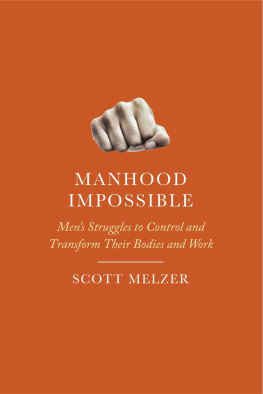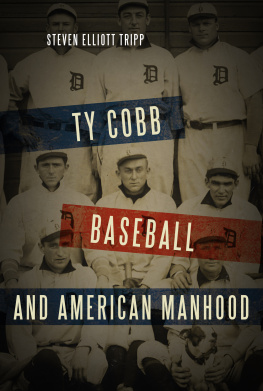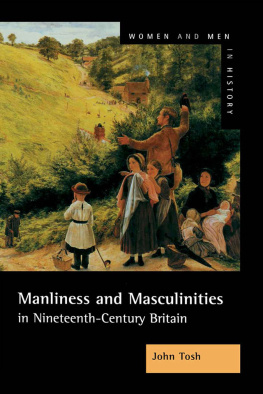Manhood on the Line
THE WORKING CLASS IN AMERICAN HISTORY
Editorial Advisors
James R. Barrett, Julie Greene, William P. Jones,
Alice Kessler-Harris, and Nelson Lichtenstein
A list of books in the series appears at the end of this book.
2016 by the Board of Trustees
of the University of Illinois
All rights reserved
1 2 3 4 5 C P 5 4 3 2 1

This book is printed on acid-free paper.
Library of Congress Cataloging-in-Publication Data
Names: Meyer, Stephen, 1942
Title: Manhood on the line: working-class masculinities in the American heartland / Stephen Meyer.
Description: Urbana, Chicago, and Springfield : University of Illinois Press, 2016. | Series: The working class in american history | Includes bibliographical references and index.
Identifiers: LCCN 2015035920| ISBN 9780252040054 (cloth : alk. paper) | ISBN 9780252081545 (pbk. : alk. paper) | ISBN 9780252098253 (e-book)
Subjects: LCSH : Automobile industry workersUnited StatesHistory. | Working classUnited StatesHistory. | Sexual division of laborUnited States. | Women employeesUnited States. | Discrimination in employmentUnited States. | Ford Motor CompanyHistory.
Classification: LCC HD 8039. A 82 M 4659 2016 | DDC 331.7/6292220973dc23
LC record available at http://lccn.loc.gov/2015035920
To:
Graham, Liam,
Stella, and Theo
As you grow older, may the world
become a nicer and fairer place
Preface
This book has taken too long to come to fruition and began many, many years ago. Much to my regret, some of this book reveals an underside of labor and union historythe rough and sometimes regressive aspects of working-class and union culture. When I began thinking about this subject in the mid-1980s, the American labor movement had begun a dismal decline resulting from a decade of management policies of de-industrialization and de-unionization. Around that time, I had a split appointment in history and labor studies with the University of WisconsinParkside and the University of Wisconsin School for Workers.
At the School for Workers mainly white and male union training sessions in Madison, I noticed few African American and female workers at the sessions for local union leaders. At the time, female and black workers were social groups that surveys indicated had the strongest desire and support for unions. From these gatherings, troubling images come to mind: for example, steelworkers would spend the evening at strip clubs, and then the next morning at breakfast, a lone woman had to sit and listen to her union colleagues talk about the previous nights foray and stories of stuffing bills into g-strings or to the machinists whose chief concern was connecting with Madison coeds on State Street. In the midst of a major crisis of union decline, the absence of black workers for leadership training or sexist male behavior of men isolated those who most desired unions.
This was not the situation for all workers and all unions. I recall attending UAW leadership training in 1988 at its Family Education Center at Black Lake. The UAW certainly had its problems with race and gender in the previous decades, but by then it had come a long way in the transformation of its union culture. The weeklong Black Lake session was diverse in its gender and racial composition and involved the full participation of its male, female, and African American workers and their families. Its evening social functions were socially and culturally mixed. By this time, the UAW had learned from its earlier problems with female and black workers of the 1960s and 1970s.
Subsequently, I began wondering about how the negative elements of male working-class culture emerged and developed over time in the industry that I knew bestthe American automobile industry. Though I consider some sectors of the American labor movement as constituting a major progressive force in our society, I have here written a work that explores more than the heroic struggles of workers and their unions in their quest to bring social equity and justice to their workplaces. The men who built unions used their masculine culture in its rough and respectable forms alike. Unfortunately, in their battle to build unions, they had to rely on its rough elements, and these became embedded in the industrial unions and the shop cultures they created. The white males who engaged in the initial struggles devised institutions that reflected their rough cultures and values and proved inhospitable to those who did not share them.
Research for this book began too many years ago when I had a yearlong fellowship at the Reuther Library at Wayne State University in the mid-1980s. While doing research for an earlier book, I had a wonderful opportunity to delve into the librarys vast collection of the records of the UAW, auto workers, labor scholars, and social critics. I discovered that some materials, especially grievance records and shop newspapers, provided windows into the workplace, into the day-to-day lives of ordinary working men and women. As a side project, I began collecting materials on sometimes odd or quirky topics around the themes of gender and race. Several hundred oral histories of auto workers from libraries around the Midwest complemented the evidence I found in the grievances and shop newspapers. These items later formed the basis of early papers on the subject this book addresses.
Schooled as I was in the social and labor history of the late 1960s and early 1970s, my historical work has always attempted to examine history from the bottom up (rather than the top down) or the history of the inarticulate of those who left few formal records of the past. Within this context, my prior work represented a sometimes-odd mix of cultural and labor history. The Five Dollar Day focused on how Ford officials attempted to transform the social and cultural lives of immigrant workers and to force them to adapt to the rigors of assembly-line mass production. Stalin Over Wisconsin explored the workplace culture of opposition of a militant and leftist UAW local in the building of the strongest and largest industrial union in Wisconsin at the Allis-Chalmers firm.
The present work, Manhood on the Line , delves more deeply into workplace culture to reveal how densely masculine the culture of automobile industrial workers actually was. It interrogates autoworker male culture in several ways: in relation to the newly evolving industrial technology; with regard to the relationship of workers to their managers and supervisors; in their relationships among other workers with different skill levels, racial backgrounds, ethnic identities, and political convictions; and in their interactions with women workers. Analytically, I probe working-class masculine culture within the context of its two polar opposites, its rough and its respectable dimensions and the blending of the two. While I examine both elements, I must confess that I emphasize the rough ones, since they have not been fully investigated elsewhere. So this is not solely an investigation of the heroic workers in their struggles with an oppressive management. Nonetheless, that struggle was important because it shaped the workers and the culture of their unions.












 This book is printed on acid-free paper.
This book is printed on acid-free paper.